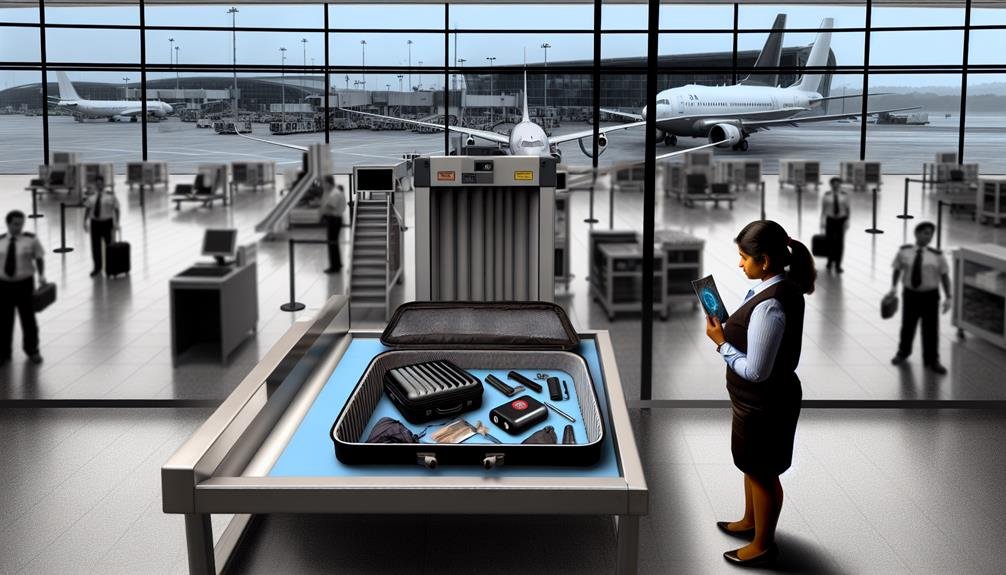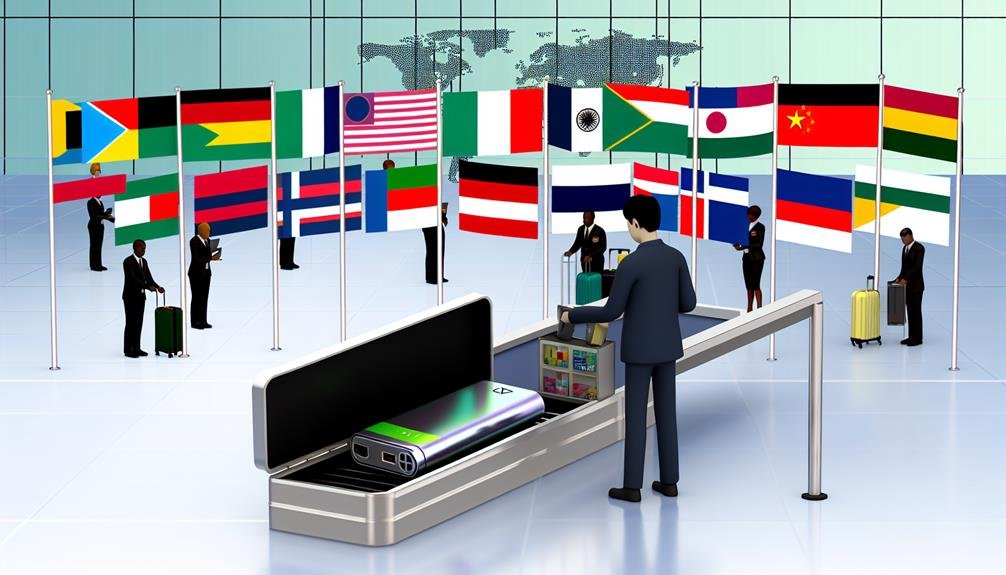You can bring lithium power banks on planes, but they have to be in your carry-on luggage. Most airlines allow power banks up to 100 watt-hours without approval. If yours is between 100Wh and 160Wh, you'll need airline approval. Power banks over 160Wh are usually prohibited. Make sure they're packed securely to prevent short circuits. Different countries have specific rules, so always check with your airline beforehand. Keeping these batteries in carry-on helps manage safety and fire risks effectively. Want to make sure you're fully prepared for your flight?
Airline Regulations

At present, most airlines have strict regulations concerning the carrying of lithium power banks on planes. These airline policies are in place to guarantee passenger safety and compliance with international travel restrictions. When you're traveling, knowing that lithium power banks are usually not allowed in checked luggage is crucial. Instead, they must be carried in your carry-on bags. This rule helps reduce the risk of potential hazards during the flight.
The capacity of your lithium power bank also plays a role. Most airlines limit power banks with a capacity exceeding 100 watt-hours (Wh) unless you have specific approval. For power banks between 100Wh and 160Wh, you might need airline permission before boarding. Anything above 160Wh is generally prohibited. To prevent travel disruptions, always check your power bank's specifications and compare them with the airline's guidelines.
Moreover, it's recommended to keep the power banks in their original packaging or a protective case to prevent short circuits. You should also make sure the device is turned off and not charging any devices during the flight. Staying informed about these airline policies will help you travel smoothly and safely.
Safety Concerns
When considering the safety concerns of lithium power banks on planes, it's important to understand the potential fire hazards they pose if not handled properly. Lithium batteries can overheat, leading to possible ignition and even explosions. These potential hazards necessitate strict security checks and regulations to guarantee passenger safety.
Before boarding, security checks will often include verifying that your power bank complies with airline voltage limits. Typically, power banks must be under a certain watt-hour (Wh) rating to be carried on board. This precaution helps reduce risks associated with overcharged or damaged batteries. Always check your power bank's specifications and verify it meets these criteria to avoid confiscation and potential safety issues.
In the unlikely event of a lithium battery catching fire, airlines have established emergency protocols to manage such situations swiftly and efficiently. Cabin crew are trained to use fire containment bags and other specialized equipment to contain and extinguish battery fires. It's essential that you follow all crew instructions and report any suspicious overheating or smoke immediately.
To minimize risks, never pack power banks in checked luggage—they should always be in your carry-on. By adhering to these guidelines, you contribute to a safer flying environment for everyone.
Capacity Limits

Understanding the capacity limits of lithium power banks is essential to guarantee they meet airline regulations and contribute to onboard safety. Airlines have specific size restrictions and travel restrictions on lithium power banks to prevent potential hazards. Generally, power banks up to 100 watt-hours (Wh) are allowed in carry-on luggage without prior approval. However, power banks between 100Wh and 160Wh usually require airline approval before you can bring them onboard. It's important to check the exact watt-hour rating, which is often marked on the device or can be calculated from its voltage and amp-hour specifications.
When planning your trip, remember that power banks exceeding 160Wh are typically prohibited from both carry-on and checked baggage due to the significant risk they pose. Always consult your airline's policy before traveling, as regulations can vary. This foresight not only guarantees compliance with travel restrictions but also ensures the safety of all passengers.
Packing Tips
Make certain your lithium power bank is easily accessible by packing it in your carry-on luggage. This is essential for both safety and compliance with airline regulations. Properly organizing your carry-on will guarantee that security personnel can quickly inspect your portable chargers and backup batteries without causing delays.
Here are some organization tips to help you achieve efficient packing:
- Use a dedicated pouch: Store your lithium power bank in a separate, easily accessible pouch within your carry-on.
- Label your items: Clearly label your portable chargers and backup batteries to avoid confusion during security checks.
- Avoid clutter: Keep your carry-on tidy to facilitate quick access and inspection.
- Check watt-hour ratings: Make certain your power banks meet airline watt-hour restrictions and keep the documentation handy.
- Securely pack cables: Use cable organizers to prevent tangling and potential damage to your devices.
International Rules

Different countries have specific regulations regarding the transport of lithium power banks on planes, and it's important to familiarize yourself with these rules before traveling. Legal requirements and travel restrictions can vary, so knowing what's permissible in advance can save you from potential headaches at security checks.
Here's a quick guide to some international rules:
| Country | Key Regulations |
|---|---|
| USA | Power banks must be in carry-on; limited to 100 watt-hours. |
| EU | Similar to the USA; check airline-specific rules. |
| China | Maximum capacity of 160 watt-hours; only for personal use. |
| Australia | Up to 100 watt-hours allowed; higher capacities need approval. |
| Japan | Limited to 160 watt-hours; must be in carry-on luggage. |
Security checks often focus on the watt-hour (Wh) rating of your power bank. Most countries allow devices with a capacity up to 100 watt-hours without special permissions, but anything above that may require airline approval or may not be allowed at all. Always make sure your power bank's watt-hour rating is clearly marked, as this is essential for compliance with international travel restrictions.
Battery Types
When selecting a power bank, you'll notice that lithium-ion and lithium-polymer batteries are the most common types available. Both offer unique benefits, but it's important to understand their differences to guarantee safety during air travel and everyday use.
- Lithium-ion batteries: These are widely used due to their high energy density and ability to hold a charge for extended periods. They're commonly found in portable chargers, offering multiple charging options for various devices.
- Lithium-polymer batteries: These are more flexible in shape and size, making them ideal for compact designs. They also have a lower risk of leaking electrolytes, enhancing safety.
While these batteries are efficient, consider the environmental impact. Proper battery disposal is essential to prevent harmful chemicals from polluting the environment. Always follow local guidelines for recycling or disposing of old batteries to minimize environmental damage.
Whether you choose a lithium-ion or lithium-polymer power bank, make sure it complies with airline regulations. Most airlines allow power banks up to 100 watt-hours, but it's always best to confirm with your carrier. Staying informed and making responsible choices guarantees both your safety and the planet's well-being.
Frequently Asked Questions
How Can I Check the Watt-Hour Rating of My Power Bank?
To check your power bank's watt-hour rating, multiply the voltage (V) by the ampere-hour (Ah) rating. Knowing this helps you comply with power bank regulations and carry-on restrictions, ensuring everyone's safety during flights.
Are There Specific Brands of Lithium Power Banks Recommended for Air Travel?
Imagine a sturdy shield in battle—choosing the best brands like Anker or RAVPower guarantees safety features are excellent. They're your reliable allies, designed for air travel, keeping both you and your devices protected.
Can I Use My Lithium Power Bank During the Flight?
You can use your lithium power bank during the flight, but check the airline's regulations first. Restrictions apply to guarantee safety. For in-flight entertainment, your portable device must comply with these regulations to avoid issues.
Do Airlines Provide Charging Stations for Lithium Power Banks on Board?
Imagine you're on a long flight and your power bank dies. Most airlines offer charging options, but power bank compatibility varies. It's best to check with your airline to guarantee seamless charging for a hassle-free journey.
What Should I Do if My Power Bank Overheats During a Flight?
If your power bank overheats during a flight, follow emergency procedures immediately. Inform the cabin crew, who are trained in safety precautions for lithium batteries. They'll handle the situation to guarantee everyone's safety on board.



